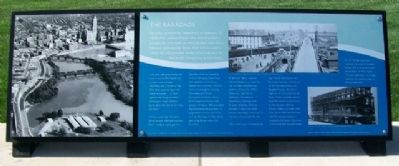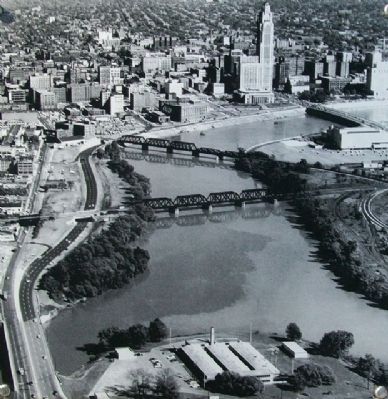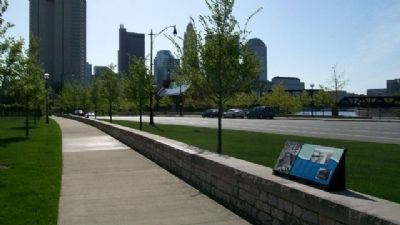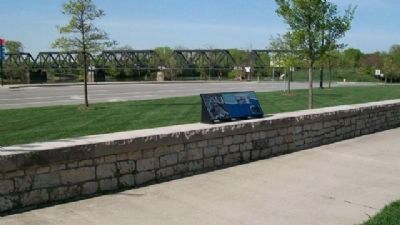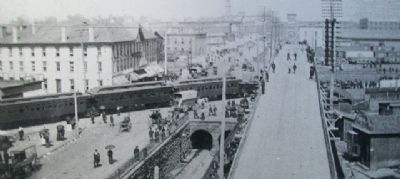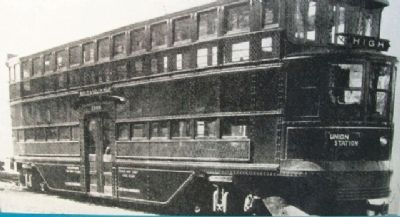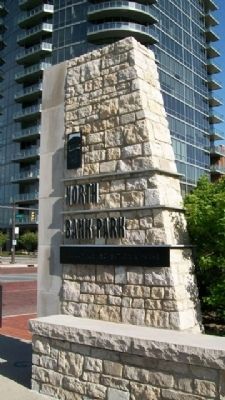Arena District in Columbus in Franklin County, Ohio — The American Midwest (Great Lakes)
The Railroads
Columbus entered the railroad era on February 20, 1850 when owners William Neil and Alfred Kelley brought the first trains on the Columbus and Xenia Railroad, spanning the Scioto River with a wooden trestle. The line provided service from Columbus to Xenia with connections to Cincinnati.
That year, with great pride, the owners invited the legislature to take a trip between Columbus and Cincinnati. The Ohio State Journal reported that it would be “...a novel sight to see the government of the great State of Ohio going off at the rate of 25 miles per hour.”
Within a year, rail lines were being bought, sold, and merged. Soon travelers could get from the Ohio River to Lake Erie without changing trains. Coal, iron, and natural resources moved from southern Ohio to river and lake ports, causing Columbus['s] and Ohio's economies to boom. Ohio's farms began providing food across the nation. Rail provided the foundation for a growth in population and the economy, and set the stage for the city to play a significant role in the Civil War.
By the late 1860s, railroad builders began to connect the city to major east/west rail systems, and by the 1870s Columbus had links to Baltimore, Philadelphia, Washington, Chicago and St. Louis, enabling Ohio to become a major industrial power. Ultimately, more than 15 rail lines crisscrossed the city.
The current day intersection of High Street and Nationwide Boulevard became the hub of rail activity, stockyards, and slaughterhouses, all joined together at the Union Station depot. Three separate depots bore the name Union Station at that location. All that remains today is a single arch from the Arcade that fronted High Street, permanently located in McFerson Common across from Nationwide Arena.
An iron bridge eventually replaced the original wooden bridge, and its steel successor exists today on the original rail bed. Used daily, the bridge demarks the eastern edge of North Bank Park.
Erected by City of Columbus.
Topics. This historical marker is listed in this topic list: Railroads & Streetcars. A significant historical month for this entry is February 1812.
Location. 39° 57.939′ N, 83° 0.671′ W. Marker is in Columbus, Ohio, in Franklin County. It is in the Arena District. Marker is on Long Street (U.S. 33), on the left when traveling east. Marker is in North Bank Park, about 550 feet west of the intersection of Long Street and Neil Avenue. Touch for map. Marker is in this post office area: Columbus OH 43215, United States of America. Touch for directions.
Other nearby markers. At least 8 other markers are within walking distance of this marker. Native Americans (within shouting distance of this marker); Transportation, Growth, and Development (about 300 feet away, measured
in a direct line); William and Hannah Neil (about 500 feet away); The Urban Face of the Scioto River (about 600 feet away); Working Class Neighborhoods (about 700 feet away); The Irish in Columbus (approx. 0.2 miles away); Columbus' First Professional Game (approx. 0.2 miles away); The Columbus Buckeyes (approx. 0.2 miles away). Touch for a list and map of all markers in Columbus.
Also see . . .
1. Columbus Railroads. Website homepage (Submitted on April 23, 2010, by William Fischer, Jr. of Scranton, Pennsylvania.)
2. Lost History Of Columbus: Union Station. Columbus Navigator website entry (Submitted on June 30, 2022, by Larry Gertner of New York, New York.)
3. Union Station (Columbus, Ohio). Wikipedia entry (Submitted on June 30, 2022, by Larry Gertner of New York, New York.)
Credits. This page was last revised on February 3, 2023. It was originally submitted on April 23, 2010, by William Fischer, Jr. of Scranton, Pennsylvania. This page has been viewed 901 times since then and 21 times this year. Photos: 1, 2, 3, 4, 5, 6. submitted on April 23, 2010, by William Fischer, Jr. of Scranton, Pennsylvania. 7. submitted on April 20, 2010, by William Fischer, Jr. of Scranton, Pennsylvania.
